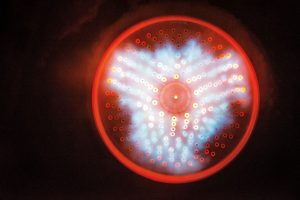Heat treating furnaces consist of several subassemblies: insulation (fiber and brick), heating systems (electric and gas), material handling, quenching, atmosphere system, process and control logic, and finally, the external skeleton, the steel structure.
Heating Element Basics
When natural gas is not available and the furnace atmosphere is endo gas or LPC (low-pressure carburizing), the type of electric heating elements selected becomes critical. The atmosphere or lack of it will determine which element design can provide the most reliable performance.
Other than induction heating systems, insulation-lined furnaces will most often have resistance heating elements like those used in household appliances such as electric ranges and toasters. Resistance heaters, as their name implies, produce heat because the materials — from which they are made — resist the flow of electricity, to a degree. Materials that completely oppose the flow of electrical energy are called insulators; materials that allow electrical flow are called conductors. If a material allows too much energy flow, the current or amperes will exceed the limits of a fusible link and blow a fuse or circuit breaker. The goal of the designer is to choose a material and cross-section that allows just enough resistance to electrical flow that it produces the appropriate heat required.
Metals consisting of chromium, nickel, iron, tungsten, and moly (molybdenum) are the most common element material, and the diameter or cross-section of the element determines its resistance. All other things being equal, the larger the cross-section, the lower the resistance. Therefore, heating elements for low power applications will always be small ribbons or minute-diameter wire. As the operating temperatures increase, the diameter of the element will increase, lowering the resistance and producing more current; a range of about 1/4″ to 1/2″ (6.35 to 12.7 mm) diameter being typical. That being said, there are applications where flat and wide elements are preferred, but still they must have the appropriate cross-section area to provide the required resistance.
Furnace Types
Endo carburizing and vacuum furnaces, especially LPC, are two of the most common recipients of heating element problems if not properly vetted. The area that receives the most attention from designers is the portion of the element that passes through the insulation and steel structure to connections outside of the chamber.
Atmosphere Furnaces
It can be easier to design for atmosphere furnaces since the heating element can be inserted into a sealed tube, sometimes called a “bayonet” element. The advantage of this design is that no part of the element comes in contact with the atmosphere or furnace steel support structure. Figure 1 is typical of a bayonet element. Another advantage of the bayonet element is it can operate on 230 or 460 AC 60 Hz voltage, eliminating the need for a stepdown transformer. The radiant tube that shields the element is simply bolted to the furnace case with traditional sealing materials, so no special electrical isolation is required; all necessary electrical insulation to isolate it from the radiant tube is provided in the element assembly. Being inside the radiant tube, the element material is exposed only to air — one of the two most desirable media for metallic elements; nitrogen gas is the other.

Over the years, some atmosphere furnace OEMs have designed heating elements where the lead-in has passed through a small opening in the refractory into an insulator integrated into the steel casing. These designs are not reliable, as the endo atmosphere can bleed through the refractory openings and drop out soot onto the insulator, causing arcing between the lead-in and steel casing.
Vacuum Furnaces
Except AFC-Holcroft’s LPC-UBQ, most vacuum furnaces do not separate the heating element assembly from the furnace atmosphere. Since most vacuum furnaces are the cold-wall variety, the thermal insulation or inner chamber is supported from the steel case by spacers. The element lead-in then passes through an opening in the inner chamber without contact. The operating temperature from a heat-loss standpoint will dictate the allowable space between the lead-in and the ID of the opening. However, the lead-in still must pass through the steel vessel without risking a short circuit, and this requires an insulator that can protect against the buildup of conductive precipitates like carbon when LPC is the process. Such insulators can consist of Teflon or other semi-rigid phenolic material with O-ring seals. The problem exists that if the LPC pressure and flow are not controlled properly, meaning that the surface of the load does not match the available acetylene (C2H2), the excess carbon produced from the cracked acetylene can settle on the lead-in insulator, potentially creating a short circuit and arcing between the steel vessel and copper lead-in. Going undetected, arcing can severely damage the lead-in and cause catastrophic consequences of a water leak into the vacuum chamber.

Heating elements made from graphite or moly can’t just float unsupported within the insulated structure but must be secured from the frame, and somewhere in that arrangement, another insulator must be used. That additional insulator also is a potential source of short circuiting if it becomes coated with carbon or from evaporated metal when using low vacuum pressure. Metals like chromium and copper can evaporate and condense on those insulators, also creating a short circuit. Figure 2 shows two typical vacuum heating element assemblies: one with (a) moly heating elements and (b) with graphite elements. Graphite heating elements cannot operate in air above 700°F (371°C); 20 percent oxygen will start to aggressively oxidize graphite, thus they are a perfect solution for vacuum furnaces and where temperatures in excess of 2,200°F (1,204°C) are encountered.
A Third Element Option

Silicon carbide can also be used as a bayonet element. Metallic element materials such as chromium and nickel are not suitable above approximately 2,000°F (1,093°C) especially when used as a bayonet inside a radiant tube. A bayonet element will always run hotter when located within a radiant tube. When such applications arise where a radiant tube is preferred in temperatures in excess of 2,000°F (1,093°C), a third option is a SiC (silicon carbide) element similar to that shown in Figure 3. These elements must hang to keep distortion to a minimum and be centered within the radiant tube with a suitable refractory spacer. SiC elements can be used well in excess of 2,400°F (1,316°C). When applications involve temperatures above 2,000°F (1,093°C), an RB (reaction bonded) SiC radiant tube is recommended. The drawback of RB SiC tubes is the difficulty in fabricating a suitable sealing flange since manufacturing these tubes with similar sealing methods as those incorporated in alloy tubes is difficult and costly. Having said that, AFC-Holcroft has developed a sealing configuration for alloy as well as RB tubes suitable for their LPC-UBQ furnace.

































